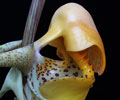|
|
|
|
|
| |
Flasks of
Coryanthes bruchmuelleri 'Henning' × self |
|
| |
|
|
| |
| Number: |
TN4407 |
| Name: |
Coryanthes bruchmuelleri 'Henning' × self
|
| Type: |
self (What's that?) |
|
Seed Donor: |
Troy C. Meyers
|
|
Click to Enlarge

Pod Parent Flower |
Click to Enlarge

Pod Parent Closeup of Flower |
Click to Enlarge

Pod Parent Blooming Plant |
|
|
|
| |
Culture Notes from Donor: Parent plant: Temperature range I (60-83°F)
Comments: Parent plant: Probably the largest-flowered species of the genus. Very strong pleasant fragrance with citrus overtones. This plant is the first-blooming seedling from our TN2005 effort of the year 2000. Its first flower was 4 inches from the top of the "cap" to the bottom of the "bucket".
For additional origin/habitat information supplied courtesy of
Charles and Margaret Baker, see further below, near the bottom of this page.
|
Temperatures we attempt to use in the lab & greenhouse:
| For Species: |
|
Spring, Summer, Autumn, Winter: days average 82°F, nights 63°F; best fit is Intermediate 83-60°F
(Source:
Baker's Web OSC) |
|
About the name...
| Etymology of |
bruchmuelleri |
|
Named for A. Bruchmüller, German collector in South America in the 19th century.
(Source:
Mayr & Schmucker 1998) |
| Etymology of |
Coryanthes |
|
From Greek "korys" helmet; "anthos" flower.
(Source:
Pridgeon 1992) |
| Pronunciation of |
Coryanthes |
|
ko-ree-AN-theez
(Source:
Pridgeon 1992) |
|
If you would like to direct someone to this web page, please copy and paste this URL into your email:
http://troymeyers.com/d?014407
| Flask Information |
| Availability: |
We have sold all of the flasks for this item. |
| You should: |
Consider getting individual plants or compots instead of a flask.
You can place a "Notify Flask Recipients" Request, and either we or a flask recipient may contact you when plants are available.
You may also place a "Notify Retries" Request, and if an identical pollination (the same parents) is done again, we'll let you know.
You may reserve a flask, but it's very unlikely you'll get one ...this could only happen if we found a flask that we didn't know we had. |
| Yield Estimate: |
630 plants (based on flask surveys done 11/05/2004 through 05/06/2005)
|
| Plantlet Sizes: |
From many flasks 50 - 160 mm plants (based on flask surveys done 03/08/2005 through 09/23/2005)
From one most recently surveyed flask 80 - 120 mm (09/23/2005)
|
|
You might also want to:
|
View the seed assay for this item.
View items of the same species.
View items of the same genus.
|
| Ordering Information |
| You are not currently logged in. |
|
You must be a registered user and be logged in to reserve a flask or place a notification request. Please log in:
|
|
|
|
|
|
| |
The origin/habitat information below is supplied courtesy of Charles and Margaret Baker
The following information is based on the name of the plant provided by the donor, and assumes that the name is correct. If the plant has been misidentified, then the following information may not be correct.
This text is copyrighted by the Bakers and may not be reproduced without permission.
ORIGIN/HABITAT: Venezuela, Brazil, and Peru. In Venezuela, plants are
found near Calderas in Barinas state at about 3000 ft. (910 m). No other
habitat details were given. Dunsterville and Garay (1966) report that this
species is also found in Brazil and Peru. In Brazil, plants grow in the
Amazonas region, but details of habitat location and elevation were not
given. In Peru, plants are found in the Department of Amazonas near
Manáos.
More about this information and the Bakers...
|
|
|
| |
|
|
|